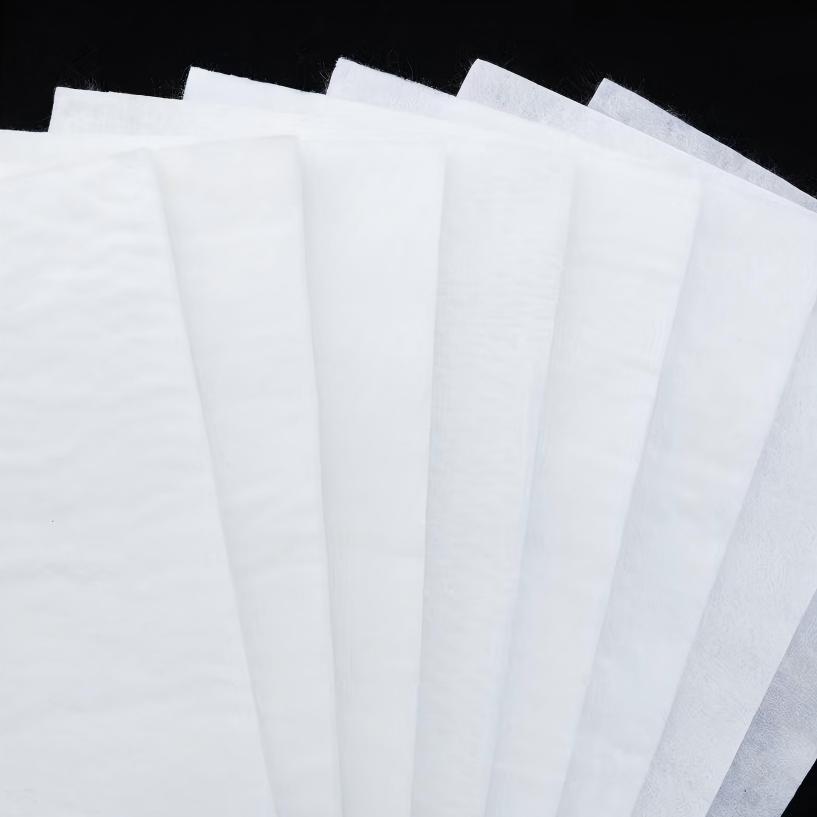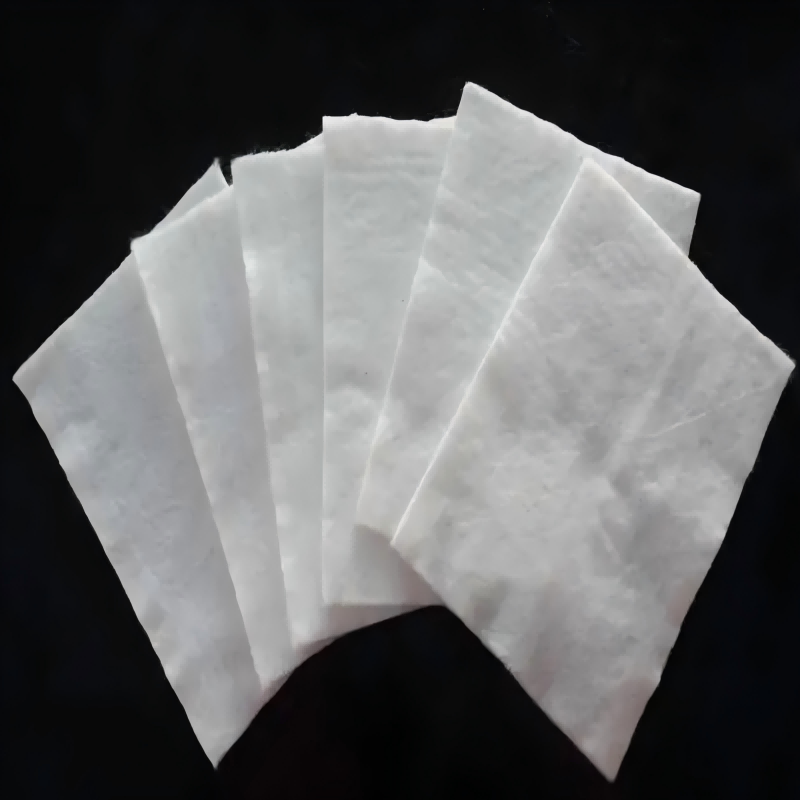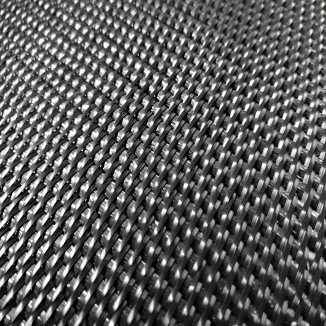Black Geotextile Fabric
1. Enhance engineering stability
Strengthening the foundation: improving soil bearing capacity, preventing settlement and landslides.
Distributed load: evenly distribute pressure to reduce the risk of local deformation.
2. Efficient isolation and filtration
Prevent material mixing: isolate different soil layers or fillers to maintain structural stability.
Permeable and impermeable soil: allowing water to penetrate while preventing soil loss.
3. Excellent drainage performance
Accelerate drainage: reduce the erosion of accumulated water on the project and improve durability.
4. Convenient and economical construction
Lightweight and easy to lay: flexible cutting, suitable for complex terrain.
Reduce engineering costs: Reduce the use of traditional materials such as sand and gravel, saving manpower and time.
Product Introduction:
Black Geotextile Fabric is a permeable geosynthetic material made from synthetic fibers (such as polyester, polypropylene, nylon, etc.) or natural fibers (such as cotton, hemp, etc., which are now less commonly used) through processes such as needle punching, weaving, weaving, and hot melting. It is not a traditional "fabric", but an industrial product with specific engineering functions, mainly used for soil reinforcement, isolation, filtration, drainage and other scenarios.
characteristic
1. Permeability: It has a reasonable pore structure that allows water or gas to pass through while preventing soil particle loss, achieving the effect of "filtering water without filtering soil".
2. High strength: Synthetic fiber material endows it with high tensile strength, tear strength, and burst strength, which can withstand loads such as soil pressure and external impact.
3. Corrosion resistance: It has strong resistance to chemicals such as acids, bases, and salts, and is not easily corroded or degraded in complex environments such as soil and sewage.
4. Weather resistance: able to adapt to different climatic conditions, such as high temperature, low temperature, UV irradiation, etc., with stable long-term performance.
5. Flexibility: The texture is soft and can be cut and laid according to the terrain of the project. It fits irregular surfaces and is easy to construct.
6. Lightweight: Compared to traditional materials such as sand and concrete, it is lighter in weight and has lower transportation and laying costs.
Product Parameters:
project | metric | ||||||||||
Nominal strength/(kN/m) | |||||||||||
6 | 9 | 12 | 18 | 24 | 30 | 36 | 48 | 54 | |||
1 | Longitudinal and transverse tensile strength / (kN/m) ≥ | 6 | 9 | 12 | 18 | 24 | 30 | 36 | 48 | 54 | |
2 | Maximum elongation at maximum load in longitudinal and transverse directions/% | 30~80 | |||||||||
3 | CBR top penetration strength /kN ≥ | 0.9 | 1.6 | 1.9 | 2.9 | 3.9 | 5.3 | 6.4 | 7.9 | 8.5 | |
4 | Longitudinal and transverse tearing strength /kN | 0.15 | 0.22 | 0.29 | 0.43 | 0.57 | 0.71 | 0.83 | 1.1 | 1.25 | |
5 | Equivalent aperture O.90(O95)/mm | 0.05~0.30 | |||||||||
6 | Vertical permeability coefficient/(cm/s) | K× (10-¹~10-), where K=1.0~9.9 | |||||||||
7 | Width deviation rate /% ≥ | -0.5 | |||||||||
8 | Unit area mass deviation rate /% ≥ | -5 | |||||||||
9 | Thickness deviation rate /% ≥ | -10 | |||||||||
10 | Thickness coefficient of variation (CV)/% ≤ | 10 | |||||||||
11 | Dynamic perforation | Puncture hole diameter/mm ≤ | 37 | 33 | 27 | 20 | 17 | 14 | 11 | 9 | 7 |
12 | Longitudinal and transverse fracture strength (grab method)/kN ≥ | 0.3 | 0.5 | 0.7 | 1.1 | 1.4 | 1.9 | 2.4 | 3 | 3.5 | |
13 | Ultraviolet resistance (Xenon arc lamp method) | Longitudinal and transverse strength retention rate% ≥ | 70 | ||||||||
14 | Ultraviolet resistance (fluorescence UV lamp method) | Longitudinal and transverse strength retention rate% ≥ | 80 | ||||||||
Product Applications:
1. Traffic engineering:
Highway and railway subgrade: used to isolate the subgrade from the foundation soil and prevent soil mixing; Drain accumulated water from the roadbed and enhance its bearing capacity.
Road maintenance: Lay it between the old and new road surfaces to reduce reflection cracks and extend the service life of the road surface.
Tunnel engineering: As a filtering layer behind the lining, it discharges water seepage from the surrounding rock and protects the tunnel structure.
2. Water conservancy engineering:
Embankment and channel: laid on the surface of the embankment or the inner wall of the channel to prevent water flow from scouring the soil, while discharging seepage water to stabilize the dam body.
River regulation: used for riverbank protection, reducing soil erosion, and improving the ecological environment of rivers.
3. Municipal engineering:
Landfill site: As an auxiliary material for the anti-seepage system, it prevents soil and groundwater from being contaminated by leachate, while also discharging gases and moisture generated by garbage.
Drainage system: used around underground drainage pipes to filter impurities and prevent pipe blockage.
4. Geotechnical Engineering:
Slope reinforcement: By reinforcing the slope, the stability of the slope is enhanced to prevent landslides.
Soft soil foundation treatment: Combined with sand and gravel cushion layer, it accelerates the drainage and consolidation of the foundation, and improves the bearing capacity of the foundation.
5. Agriculture and Ecological Engineering:
Irrigation of farmland: used for channel seepage prevention and drainage, improving water resource utilization efficiency.
Ecological restoration: auxiliary materials used for soil improvement and vegetation restoration in mining reclamation and wetland restoration to prevent soil erosion.
In short, geotextile has become an indispensable key material in modern civil engineering due to its unique properties and advantages, playing an important role in improving engineering quality, reducing costs, and promoting green construction.












